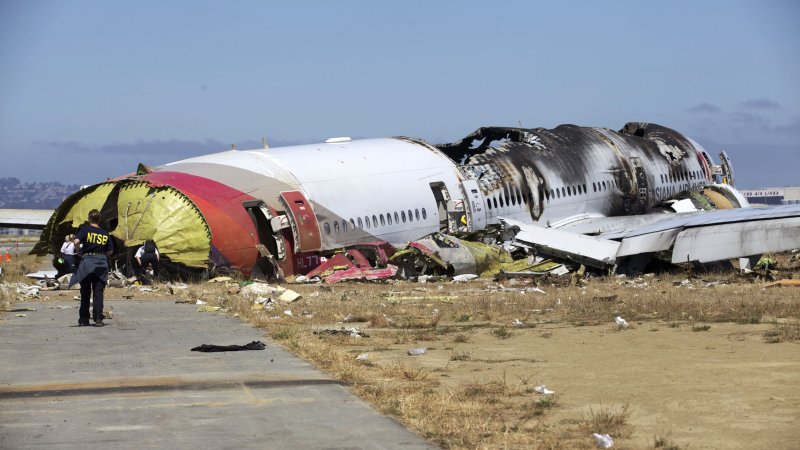1 of 4 | In this photo provided by the National Transportation Safety Board, NTSB investigators inspect the scene of the crash of Asiana Flight 214 in San Francisco, California on July 7, 2013. The Boeing 777 was en route from Shanghai with a layover in Seoul, South Korea, carrying 291 passengers. Two people died and more than 180 were injured. Pilot Lee Kang-kook had logged more than 9,000 hours on various aircraft, but only 43 hours on the Boeing 777 and was considered still in training on that aircraft. UPI. |
License Photo
SAN FRANCISCO, July 9 (UPI) -- The pilots at the controls of Asiana Airlines Flight 214 were not tested for drugs or alcohol after the plane crashed in San Francisco, officials said Tuesday.
NTSB Chairwoman Deborah A.P. Hersman told reporters at a news conference in San Francisco flight crews for commercial operators based in the United States are required to be tested for drugs and alcohol after a crash, but those requirements don't apply to commercial operators based in foreign countries, and the crew was not drug tested. Asiana Airlines is based in South Korea.
Hersman said investigators had interviewed three of the four pilots on board the flight, including the three who were in the cockpit at the time of the crash, in which two passengers were killed and 182 passengers and crew were injured.
The fourth pilot, a relief captain who was seated in the cabin at the time of the crash, was still being interviewed.
Hersman said the pilot flying the aircraft said he had 9,700 hours of total flight time and about 5,000 hours as pilot in command, but he was still in his "initial operating experience" in the Boeing 777. He had completed 10 legs and logged 35 hours on the 777, about halfway through his initial operating experience on the jumbo jet. He was a captain on the Airbus A320 from 2005-2013 prior to moving to the 777.
The instructor pilot, seated to the right of the flying pilot, said he had 13,000 hours total flight time and about 3,000 hours on the 777, with a total pilot-in-command time of 10,000 hours. He spent a decade in the Korean air force. This was his first outing as an instructor pilot and was the pilot in command on Flight 214.
The relief first officer said he had 4,600 hours flight time and 900-1,000 hours flying the 777, and said he flew F-5s and F-16s in the Korean air force.
Hersman said all crew members had been cooperative and forthright.
Lee Yoon Hye, who was one of 12 flight attendants on the plane, is being hailed as a hero for moving passengers out of the plane to safety, CNN reported Tuesday.
The 18-year veteran of Asiana said after the Boeing 777 hit the runway with "great impact," overhead bins dropped open and an inflatable escape slide inflated inside the cabin.
"As soon as I heard 'emergency escape,' I conducted the evacuation," she said at a news conference with Korean journalists in San Francisco. "I was not thinking, but acting."
Lee said other flight attendants worked to free a crew member who had been trapped by the inflating slide and helped passengers as a fire began at the rear of the aircraft.
One flight attendant hoisted onto her back a scared young boy and they went down the slide together, Lee said.
Lee, who said she was the last to leave the plane, said the ceiling was coming down as she escaped.
Crash investigators say a critical part of the aircraft's automatic landing system was not working, so the pilot was forced to land the plane manually. Approaching the runway, the plane was too low and too slow, the Los Angeles Times reported.
The crash is "an unfortunate textbook example" of questionable decision making by flight crews in the mere seconds before landing, said Najmedin Meshkati, an engineering safety expert at the University of Southern California.
"There was no discussion of any problems clearly at a time when one was developing. Both pilots should have seen that something was going wrong," aviation safety expert Barry Schiff, a Trans World Airlines pilot for 34 years, told the Times, commenting on cockpit voice recordings. "Why didn't one of them say or do something?"
The U.S. National Transportation Safety Board said it would interview all four pilots aboard the aircraft -- the two at the controls and two relief pilots for the long flight -- to determine why the crew members did not appear to recognize the danger the plane faced and take action.
Hersman said investigators would closely examine the crew's coordination in the cockpit.
"We're looking at what they're doing and why they were doing it," Hersman said. "We want to know what they understood."
Two teenage passengers were killed and 182 other passengers and crew members were injured when Flight 214 from Seoul, a Boeing 777-200ER with 291 passengers and 16 crew members, crash-landed.
One passenger fatality may have resulted from a responding fire vehicle.
The massive jetliner hit a San Francisco Bay seawall, snapping off its tail section before skidding to a stop and catching fire on Runway 28L.
The South Korean Transport Ministry said pilot Lee Kang-guk had only 43 hours of experience flying a 777.
It was Lee's first time piloting a 777 into the San Francisco airport, an Asiana spokeswoman said.
But Lee had many thousands of hours in other Boeing aircraft, including the 747, transport and airline officials said.
Lee was being supervised by more experienced Capt. Lee Jung-min, though he too did not call for the landing to be aborted, a term known as a "go-around," until 1.5 seconds before the crash, cockpit voice recordings indicated.
That was far too late for the abort to occur.















